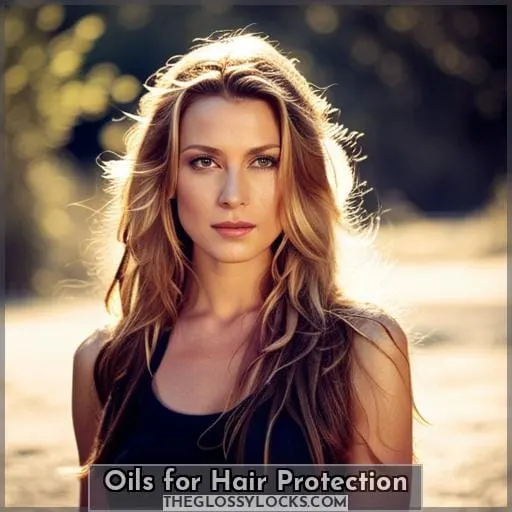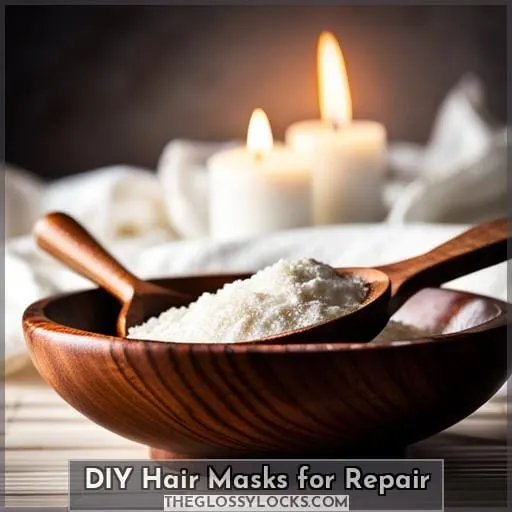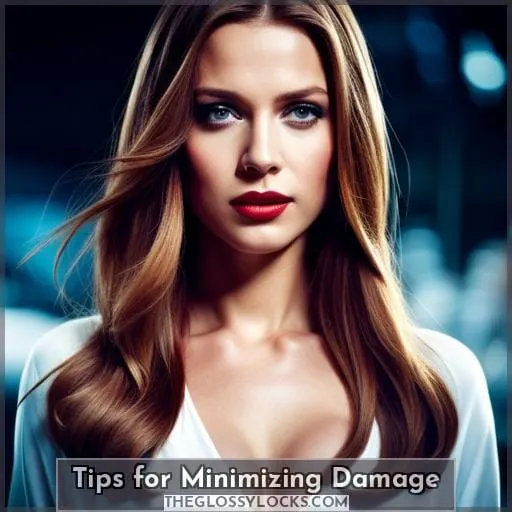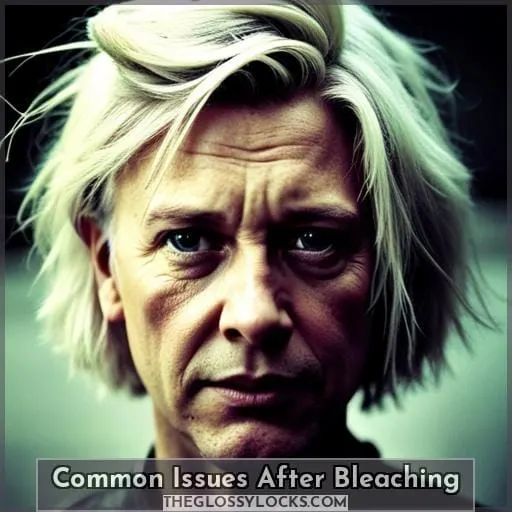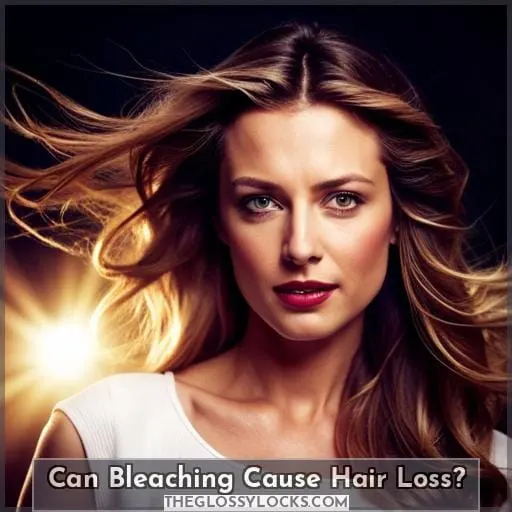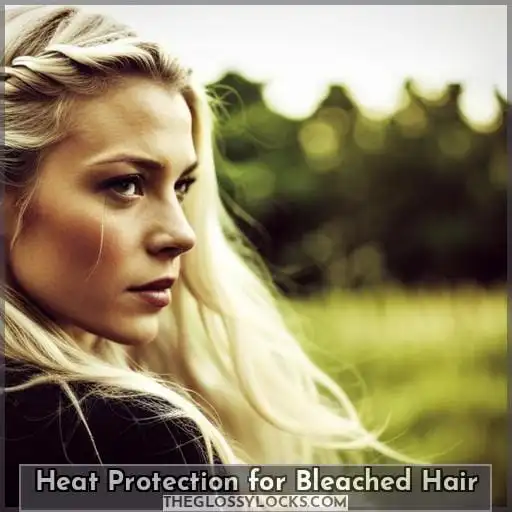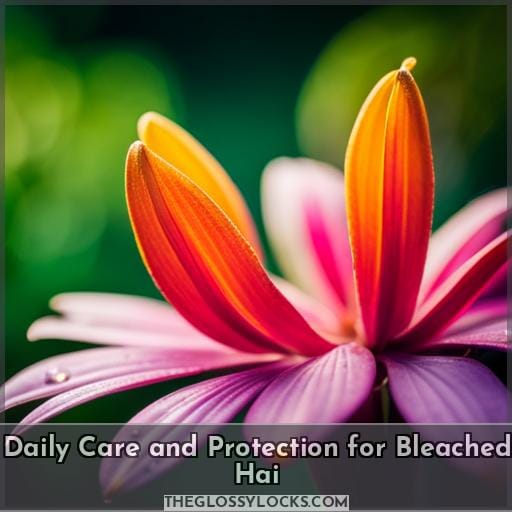This site is supported by our readers. We may earn a commission, at no cost to you, if you purchase through links.
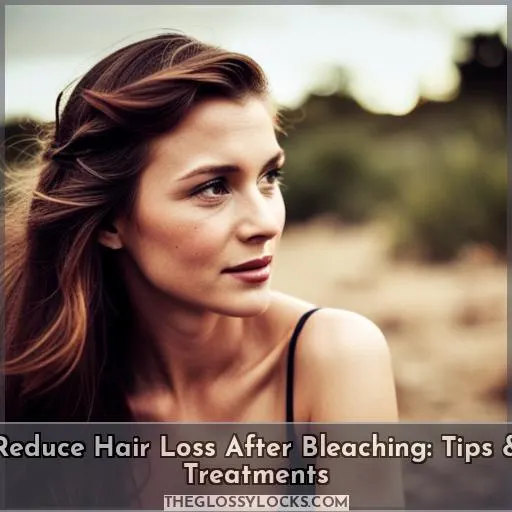 Looking to reduce hair loss after bleaching? Discover effective tips and treatments that can help you protect and repair your hair.
Looking to reduce hair loss after bleaching? Discover effective tips and treatments that can help you protect and repair your hair.
By using oils, DIY masks, and minimizing damage through proper care, you can maintain the health of your bleached hair.
Find out if bleach itself causes hair loss and learn how to protect your strands from further damage.
With these nourishing treatments and essential knowledge, you’ll be on your way to healthier, stronger post-bleach locks in no time.
Table Of Contents
- Key Takeaways
- Oils for Hair Protection
- DIY Hair Masks for Repair
- Tips for Minimizing Damage
- Common Issues After Bleaching
- Can Bleaching Cause Hair Loss?
- How to Protect Hair From Damage
- Nourishing Treatments for Hair Health
- Importance of Deep Conditioning
- Heat Protection for Bleached Hair
- Daily Care and Protection for Bleached Hai
- Frequently Asked Questions (FAQs)
- Can I use regular cooking oils like olive oil or coconut oil to protect my hair after bleaching?
- Are there any natural remedies or home remedies that can help reduce hair loss after bleaching?
- How long should I wait after bleaching my hair before I can start using heat styling tools again?
- Is it normal to experience hair breakage and shedding after bleaching? How long does it typically last?
- Are there any specific vitamins or supplements that can help promote hair regrowth and prevent further hair loss after bleaching?
- Conclusion
Key Takeaways
- Use oils such as olive, coconut, argan, and almond oil to moisturize and strengthen hair after bleaching.
- Limit heat styling and choose lower temperature settings on hot styling tools to minimize damage.
- Seek professional help if experiencing significant hair loss after bleaching.
- Incorporate pH-balanced treatments to promote scalp health and reduce hair loss after bleaching.
Oils for Hair Protection
To protect your hair after bleaching, using oils can be beneficial.
Olive oil is great for restoring moisture by applying a few drops to the ends of your hair.
Coconut oil can help with dry and frizzy spots, while argan oil adds shine and seals in moisture after styling.
Additionally, almond oil strengthens the hair and prevents breakage when applied daily.
Don’t forget to use sun protection products to shield your bleached hair from heat and sun damage as well.
Olive Oil
To protect your hair after bleaching, apply a few drops of olive oil to the ends for added moisture and hydration.
Olive oil benefits include:
- Restoring moisture
- Hydrating the hair
- Promoting scalp health
- Reducing hair breakage.
Coconut Oil
Coconut oil is another hydrating oil that can effectively protect your bleached hair from damage and promote its overall health.
- Reducing hair loss after bleaching
- Preventing breakage
- Aiding in the recovery of damaged hair
Argan Oil
In the previous section, we explored the benefits of coconut oil for protecting bleached hair.
- Argan oil benefits
- Argan oil application
- Argan oil for shine
Almond Oil
If you’re looking for a nourishing oil to protect your bleached hair, try using almond oil.
- Strengthening the hair cuticle
- Preventing breakage
Almond oil can be used in hair masks or as a leave-in conditioner alternative.
Use Sun Protection
To protect your bleached hair from heat and sun damage, apply a few drops of an SPF product to the ends.
Sun protection is crucial for maintaining hair health and preventing further damage caused by bleaching effects on the hair structure.
DIY Hair Masks for Repair
To repair your bleached hair and reduce hair loss, you can try DIY hair masks using ingredients like avocado, honey, egg white, and rice water.
Avocado is rich in vitamins and fatty acids that nourish the hair while honey adds moisture and elasticity.
Egg whites provide protein to strengthen damaged strands while rice water helps improve the overall strength of your hair.
Incorporating these natural remedies into your routine can help restore health to your bleached locks.
Avocado, Honey, and Egg White
You can create a nourishing hair mask using avocado, honey, and egg white to repair your bleached hair. DIY Hair Masks like this one can help improve the texture of your hair and address styling difficulties caused by bleaching.
Avocado provides essential nutrients for healthy hair growth, while honey moisturizes and adds shine.
Incorporate this DIY treatment into your regular hair hygiene routine for optimal results in repairing damaged bleach-treated hair.
Rice Water Rinse
When repairing your bleached hair, one effective DIY hair mask option is a rice water rinse.
Rice water has numerous benefits for your hair, including strengthening the strands and promoting scalp health. It can help prevent further hair loss after bleaching by nourishing the cuticle layers and repairing any damage to the cortex.
Incorporate a rice water rinse into your natural hair care routine for healthier, stronger locks.
Leave-in Conditioner
After bleaching your hair, it’s important to incorporate a leave-in conditioner into your routine for repair and nourishment.
Leave-in conditioners provide numerous benefits such as:
- Hydrating the hair
- Reducing frizz
- Improving manageability
- Protecting against heat styling
When choosing products, look for those with ingredients like aloe vera that promote hydration and repair damaged strands.
Apply the leave-in conditioner evenly throughout damp or dry hair using your fingers or a wide-toothed comb for maximum effectiveness.
Tips for Minimizing Damage
To minimize damage to your bleached hair, there are several tips you can follow:
First, avoid excessive heat styling and limit it to once or twice a week.
Be cautious when exposing your hair to chlorine in pools and protect it with a swimming cap or special products.
When combing your hair, make sure it’s wet and use a wide-toothed comb or wet brush for gentler detangling.
Additionally, cut back on shampooing frequency to retain natural oils and opt for cool water washes followed by cool rinses for added protection against damage.
Finally, regularly schedule trims to get rid of split ends and maintain the health of your bleached locks.
Avoid Heat Styling
To minimize damage to your bleached hair, avoid excessive heat styling.
Opt for cool water washes, air drying, and using hair elastics that don’t cause tension.
Be Careful With Chlorine
To minimize damage to your bleached hair, it’s important to exercise caution when exposed to chlorine.
Follow these tips for chlorine protection:
- Rinse your hair with fresh water before swimming.
- Wear a swim cap or tie your hair up in a bun.
- Apply a leave-in conditioner or oil treatment before swimming.
- After swimming, wash and condition your hair thoroughly to remove any residual chlorine.
Only Comb Hair When Wet
Comb your hair only when it’s wet to minimize damage.
Wet combing helps detangle the hair more easily, reducing breakage and preserving moisture. This technique is crucial for post-bleach care and preventing further hair loss.
Cut Back on Shampoos
Cut back on shampoos to minimize damage and maintain the health of your bleached hair.
- Reduce shampooing frequency.
- Consider natural alternatives like rosemary oil.
- Seek professional advice for scalp issues or hair loss.
Cool Water Washes
When it comes to minimizing damage after bleaching, one effective tip is to opt for cool water washes.
Cool water helps reduce scalp irritation and minimizes hair loss, thinning, and breakage.
Go for a Trim
To minimize damage and promote healthy hair growth after bleaching, consider getting a trim.
Trimming your hair regularly helps prevent split ends, maintains stylish haircuts, and ensures proper hair maintenance.
| Trim Benefits | Trimming Frequency | Stylish Haircuts |
|---|---|---|
| Split End Prevention | Every 6-8 weeks | Stay on trend |
Getting regular trims is essential for maintaining the health of your bleached hair. Bleaching can weaken the structure of your strands and make them more prone to split ends. By trimming off these damaged ends every 6-8 weeks, you prevent further splitting from traveling up the shafts of your hairs.
In addition to preventing split ends, regular trims also allow you to maintain stylish cuts or hairstyles that may have been affected by bleach damage. Your hairstylist can shape and style your locks in a way that complements both current trends and suits your personal preferences.
Furthermore, frequent trimming supports overall hair maintenance after bleaching by keeping it looking fresh and healthy. It removes any dry or brittle portions caused by chemical treatments while promoting smoother texture throughout the lengths of each strand.
Overall, incorporating routine trims into post-bleach care helps minimize damage while promoting optimal growth conditions for healthier-looking tresses.
Common Issues After Bleaching
After bleaching your hair, it’s common to experience issues such as:
- Hair falling out
- Scalp problems
- Hair breakage
These issues can be caused by the harsh chemicals used in the bleaching process and the damage they inflict on the hair and scalp.
Understanding these common problems after bleaching is crucial for finding effective solutions to reduce further damage and promote healthy regrowth.
Hair Falling Out
If your hair is falling out after bleaching, it’s important to seek professional help immediately.
Hair maintenance is crucial in addressing this issue and promoting hair regrowth.
The effects of bleaching on the hair can weaken its structure and lead to breakage.
Consulting with a professional will allow for an accurate assessment of the situation and appropriate treatments tailored to your specific needs, helping restore healthy hair texture.
Scalp Issues
If you experience scalp issues after bleaching, such as irritation or inflammation, it’s important to address these concerns promptly.
Bleach can harm the scalp’s skin barrier and disrupt the hair cycle, leading to hair loss and thinning.
To promote recovery and regrowth, focus on scalp health by using treatments that repair damage and restore moisture.
Regular use of a pH-balanced treatment can support hair growth while protecting against further damage from bleach.
Hair Breakage
If you’ve experienced hair breakage after bleaching, it’s important to address this common issue and take steps to repair and strengthen your hair.
- Hair Strengthening:
- Incorporate hydrating oils like olive oil, coconut oil, argan oil, or almond oil into your routine to restore moisture and prevent breakage.
- Breakage Prevention:
- Use DIY hair masks with ingredients like avocado, honey, egg white or rice water rinse to nourish the strands and improve elasticity.
- Scalp Care:
- Comb wet hair with a wide-toothed comb or wet brush to minimize damage;
- Reduce shampoo frequency;
- Use lukewarm water for washing followed by cool water rinse;
- Get regular trims.
- Damage Mitigation:
- Seek professional help if experiencing significant issues such as difficulty brushing hair or unwanted color changes;
- Consider natural regrowth techniques like scalp massage with rosemary oil.
By following these tips for strengthening your damaged tresses while caring for both scalp health and overall well-being of the mane post-bleaching session can aid in preventing further damage caused by chemical treatments on delicate strands.
Can Bleaching Cause Hair Loss?
After bleaching, it’s important to be aware of the potential effects on your hair and scalp. One common concern is whether bleaching can cause hair loss. While temporary hair loss can occur as a reaction to bleach or hair color, continued and significant hair loss could indicate a deeper issue that requires professional attention.
Bleach contains harsh chemicals that can lead to protein loss in the hair, weakening its structure and making it appear thinner. The process of bleaching affects the core structure of the hair, resulting in temporary thinning.
Additionally, bleach can penetrate the follicles and disrupt the scalp’s skin barrier (acid mantle), leading to irritation and inflammation.
If you experience noticeable shedding or breakage after bleaching, it’s crucial to discontinue treatment immediately for your scalp’s recovery.
| Recovery Recommendations | Bond Repair |
|---|---|
| Discontinue Bleach Use | Strengthen Existing Bonds |
| Use Hair & Scalp Treatment | Protect & Fortify Bleached Hair |
| Restore Moisture |
These recommendations will help repair damage caused by bleach while restoring moisture levels in both your strands and scalps so they may regain their health.
How to Protect Hair From Damage
To protect your hair from damage, incorporate regular use of protective sprays or serums into your daily routine. These products provide a shield against the harmful effects of bleaching and help maintain hair hydration.
Here are some tips to prevent damage and keep your scalp healthy:
- Use hydrating oils like olive oil, coconut oil, argan oil, or almond oil to restore moisture and strengthen your hair.
- Try DIY masks with ingredients such as avocado, honey, egg white for added softness and elasticity.
- Limit heat styling to once or twice a week to minimize damage caused by high temperatures.
- Be cautious when exposed to chlorine in pools by wearing a swim cap or rinsing off immediately after swimming.
- Comb wet hair using wide-toothed combs or wet brushes instead of fine-toothed ones.
By following these practices consistently along with incorporating other recommended treatments mentioned earlier in this article—such as deep-conditioning for elasticity and moisture—you can significantly reduce the risk of further damage while keeping your bleached locks healthy.
Nourishing Treatments for Hair Health
To nourish and restore hair health after bleaching, try incorporating these nourishing treatments into your routine.
Hair revitalization is crucial in maintaining the strength and vitality of your locks. Start by focusing on scalp care, as a healthy scalp promotes healthy hair growth. Utilize natural remedies such as avocado, honey, and egg white masks to provide essential nutrients for softness and elasticity.
Additionally, consider seeking professional advice to tailor a treatment plan specifically for you. Styling solutions play a vital role in preventing further damage caused by heat styling tools or environmental factors like chlorine exposure.
Incorporating deep conditioning treatments can also help replenish moisture lost during the bleaching process while providing necessary hydration for elasticity restoration. Look for products that contain ingredients like keratin or collagen to strengthen weakened strands from within.
Remember that proper heat protection is essential when using blow-dryers or irons on bleached hair; opt for lightweight protective sprays or serums with added UV filters to shield against harmful rays.
By prioritizing these nourishing treatments along with regular maintenance appointments at the salon—such as trims—you’ll be well on your way toward healthier-looking post-bleach tresses.
Importance of Deep Conditioning
To maintain the health and strength of bleached hair, it’s essential to regularly deep condition with a nourishing treatment. Deep conditioning provides numerous benefits that are crucial for post-bleaching care and hair repair.
Firstly, deep conditioning restores moisture to dry and damaged strands, replenishing hydration lost during the bleaching process. This moisture restoration not only improves the overall appearance of your hair but also enhances its elasticity, making it less prone to breakage.
Deep conditioning treatments work by penetrating deeply into the hair shaft, delivering intense nourishment and repairing any damage caused by bleach. These treatments contain ingredients such as oils, proteins, and vitamins that strengthen weakened strands from within while providing essential nutrients for optimal growth.
By incorporating regular deep conditioning sessions into your post-bleaching routine, you can effectively restore moisture balance in your tresses while enhancing their elasticity. This will help prevent further damage from occurring due to daily styling or environmental factors like heat or UV rays.
In conclusion, deep conditioning is an indispensable step in maintaining healthy bleached hair. It offers multiple benefits including moisture restoration, elasticity enhancement, and overall improvement in strand strength.
Make sure to include this important step in your post-bleaching care regimen to keep your locks looking vibrant and minimize potential issues associated with chemical processing.
Heat Protection for Bleached Hair
To protect your bleached hair from further damage, use a heat protection spray or serum before styling with hot tools.
Bleaching aftermath can leave your hair more vulnerable to heat damage due to its weakened state. Heat protection products form a barrier on the surface of each strand, shielding it from the intense temperatures of blow dryers, straighteners, and curling irons.
These products help maintain hair resilience by reducing moisture evaporation and preventing excessive dryness caused by high heats.
When choosing a heat protection spray or serum for bleached hair, look for formulations that offer not only thermal defense but also nourishing ingredients to support the health of your strands. Consider seeking professional guidance in selecting the right product tailored specifically for post-bleach care.
Remember that using proper styling strategies is crucial when dealing with chemically treated locks. Opt for lower temperature settings on hot tools whenever possible and limit exposure time to minimize potential damage.
By incorporating heat protection into your daily routine after bleaching, you can ensure long-lasting results while maintaining healthy-looking tresses.
Daily Care and Protection for Bleached Hai
To maintain the health and strength of your bleached hair, it’s important to incorporate daily care and protection into your hair care routine.
One way to promote scalp health is through regular scalp massages. Massaging the scalp increases blood circulation, which can stimulate hair growth and strengthen follicles. Additionally, you may consider using natural remedies such as onion juice or peppermint oil on your scalp.
Onion juice has been associated with potential hair regrowth due to its high sulfur content, while peppermint oil can help relieve itching and flakiness.
Another beneficial ingredient for bleached hair is aloe vera. Aloe vera has moisturizing properties that can hydrate dry strands caused by bleach damage.
Furthermore, witch hazel offers relief for irritated scalps after bleaching by reducing inflammation and balancing pH levels in the skin.
Incorporating these daily care practices along with protective measures will help keep your bleached locks healthy, strong, and protected from environmental stressors like pollution or UV rays.
Frequently Asked Questions (FAQs)
Can I use regular cooking oils like olive oil or coconut oil to protect my hair after bleaching?
Using regular cooking oils like olive oil or coconut oil after bleaching may not provide sufficient protection.
Opt for specific hydrating oils such as argan or almond oil, which are formulated to restore moisture and strengthen hair.
Are there any natural remedies or home remedies that can help reduce hair loss after bleaching?
To reduce hair loss after bleaching, consider using natural remedies.
Avocado, honey, and egg white masks can promote softness and elasticity.
Scalp massages with rosemary oil or onion juice may stimulate potential regrowth.
How long should I wait after bleaching my hair before I can start using heat styling tools again?
To maintain the health of your bleached hair, allow a minimum of two weeks before using heat styling tools. This interval helps minimize further damage and gives your hair time to recover from the bleaching process.
Is it normal to experience hair breakage and shedding after bleaching? How long does it typically last?
Experiencing hair breakage and shedding after bleaching is common. It typically lasts for a few weeks to months, depending on individual factors.
Using bond repair treatments and gentle care can help minimize damage and promote healthy regrowth.
Are there any specific vitamins or supplements that can help promote hair regrowth and prevent further hair loss after bleaching?
To promote hair regrowth and prevent further loss after bleaching, consider taking biotin supplements.
Biotin supports healthy hair growth by strengthening the keratin protein structure.
Consult with a healthcare professional for personalized advice.
Conclusion
In your quest to reduce hair loss after bleaching, you’ve discovered a range of effective tips and treatments.
By incorporating oils like olive oil, coconut oil, argan oil, and almond oil into your routine, you can protect and nourish your hair.
DIY hair masks, such as avocado, honey, and egg white or a rice water rinse, can help repair damage.
Minimizing heat styling, being cautious with chlorine, and cutting back on shampooing can also minimize further damage.
With these strategies, you can maintain healthier, stronger post-bleach locks.

